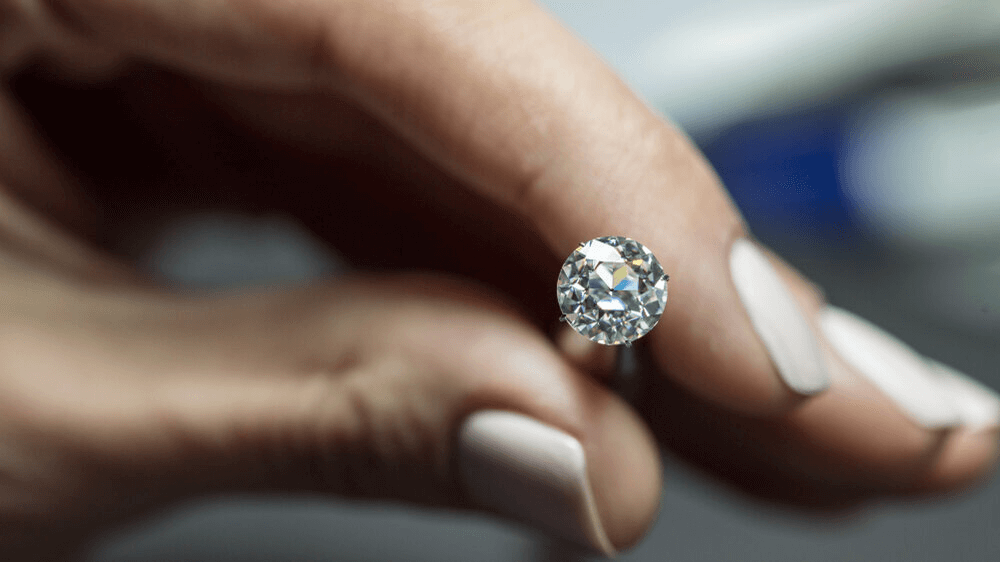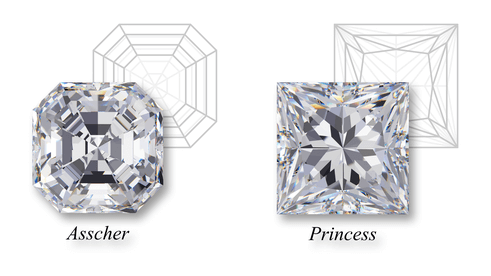Unlock the Secret to Pear Shaped Diamonds

By Gary A.

Edited by Olivia H.
Published May 11, 2021
Edited on Mar 31, 2025
With its graceful curves and timeless appeal, a pear shaped diamond offers a perfect blend of elegance and sparkle, making it a captivating choice for anyone seeking a truly unique engagement ring.

Navigate This Guide:
- 7 Quick Tips for Buying a Pear-Shaped Diamond Engagement Ring
- Introduction
- What We Mean by ‘Pear Shaped Diamond’
- The Unique History of Pear Diamonds
- Understanding Diamond Anatomy
- Pear Shaped Diamonds: Pros and Cons
- Choosing a Pear Cut Diamond: Key Factors to Consider
- Pear Diamond Cost Considerations
- Pear Diamond Engagement Rings
- Our Expert Take
- 10 FAQs
Before we dive deeper into the specifics, here are some practical tips to help guide your decision-making process:
7 Quick Tips for Buying a Pear-Shaped Diamond Engagement Ring
- Tip 1:Check the Length-to-Width Ratio: The length-to-width ratio of a pear-shaped diamond affects its overall appearance. A classic pear shape typically has a ratio between 1.55 and 1.75. This ratio ensures that the diamond has the desirable teardrop shape without appearing too elongated or too round. Tip: Visualize different ratios to see which shape appeals to you the most. Remember, personal preference plays a significant role here.
- Tip 2:Look for Symmetrical Shape: Symmetry is crucial for pear-shaped diamonds. A well-cut pear diamond should be symmetrical, with its sides evenly curved and the point aligning with the apex of the rounded end. Tip: Examine the diamond closely to ensure that one side isn’t flatter or more curved than the other. The point should also be sharp and perfectly aligned with the round end.
- Tip 3:Be Aware of the Bow-Tie Effect: Many pear-shaped diamonds exhibit a bow-tie effect, a visible dark area across the center that resembles a man’s bow tie. While it’s nearly impossible to find a pear-shaped diamond without any bow-tie effect, it shouldn’t be overly dominant. Tip: Observe the diamond under various lighting conditions. A slight bow-tie can add character, but a prominent one can detract from the stone’s beauty.
- Tip 4:Consider the Color Grade: Pear-shaped diamonds can show color more readily than other shapes, especially at the pointed end. Tip: If the diamond is to be set in white gold or platinum, opt for a higher color grade (H or above). For yellow gold or rose gold settings, you can choose a lower color grade without compromising the diamond’s appearance.
- Tip 5:Focus on the Clarity: Like color, the clarity of pear-shaped diamonds is crucial. They can hide inclusions well, especially at the rounded end. Tip: Look for a diamond with a clarity grade of SI2 or higher for the best value. Ensure that any inclusions are not visible to the naked eye, particularly near the point, where they can be more noticeable.
- Tip 6:Evaluate the Setting Style: The setting plays a significant role in both the appearance and the protection of the diamond. Pear-shaped diamonds have a pointed end that can be prone to chipping. Tip: Choose a setting that protects the point, such as a prong setting with a V-shaped prong at the tip. Additionally, consider a setting that complements the unique shape of the pear diamond, such as a halo or solitaire setting.
- Tip 7:Assess the Overall Aesthetics and Personal Preference: Beyond technical aspects, the overall look of the diamond and how it suits personal taste is crucial. Tip: Consider how the diamond looks on the hand. Does it complement the finger shape? Is the size proportionate? Ensure that the diamond aligns with the wearer’s style and preferences.
Now that you’ve got these practical tips, use Jeweler AI below to find the perfect engagement ring that suits your style and budget:
Introduction
We talk a lot about the versatility of different diamond shapes and, for the most part, the message is the same: all of the most popular cuts lend themselves to a wide range of different styles, ring designs and accents. Nevertheless, few offer as much scope for personalization as the Pear.
From the fact that it can be arranged to sit in a wide range of different directions on the finger, to its ability to look either super plush and glamorous to incredibly modern and minimalistic, the Pear cut is one that continually comes back into popular favor – particularly among celebrities.
The benefits of choosing this cut are hard to deny, there’s a lot more you need to know about it before you decide it’s going to take center stage on your own engagement ring design.

What We Mean by ‘Pear Shaped Diamond’
The Pear shape is a combination of the Round Brilliant and Marquise diamond cuts, with a tapered point at one end and a rounded end at the other.
As a result of the Brilliant facet pattern, this cut is known for its tremendous sparkle. It is also called a teardrop or drop cut, as it resembles a drop of water. A typical Pear shape contains 58 facets, with the number of pavilion facets ranging from 4 – 8.
Unlike some other cuts, there is a lot of discrepancy between the exact shape of the Pear. This can make it trickier for shoppers to find a worthwhile diamond to buy but, armed with a little research, they can definitely make a great choice.
One of the most notable things to realize about the Pear cut is the fact that it is asymmetrical. The Heart is another notable example of this but, for the most part, as far as diamond cuts go, this is pretty unique. We will look at this in more detail below but, for now, it’s important to keep in mind.
Pear Diamond Rarity
Compared to the most popular diamond shapes, Pear diamonds are relatively rare, but they’re not hard to come by if you’re worried about finding one.
Pear cut diamonds account for about 4% of diamonds on the market today – a number that can make them sound rarer than they really are. In truth, plenty of brides wear this cut, although the number of Round, Oval and Princess diamonds featured in engagement rings will inevitably make every other cut sound ‘rare’ in comparison.
Pear Diamond Superstitions
Over the years, the Pear’s resemblance to a teardrop has not gone unnoticed, with some superstitious folk stating that such a close similarity between the two means that brides who are proposed to with a Pear will inevitably be left weeping.
But, given the number of happy brides out there wearing the Pear cut, we prefer to think of this beautiful shape as being a symbol of tears of happiness, rather than sadness or misfortunate.
Nevertheless, if your partner is the superstitious type, you might be better off looking at another cut.
The Unique History of Pear Diamonds
The Pear shape has been around for centuries, with the first one created way back in the 1400s by Flemish cutter, Lodewyk van Berquem of Bruges. He was also the inventor of the diamond-polishing wheel (scaif), which revolutionized how diamond cutters created those glassy facets after the initial cuts were made.
The romantic and feminine curves of the Pear shape have many celebrities wearing this comeback style. Elizabeth Taylor famously turned her teardrop diamond engagement ring into a necklace, while other such as Victoria Beckham, Princess Charlene of Monaco, and Anna Kournikova, wear the stunner on their fingers.
Pear vs Teardrop
Pear and Teardrop refer to the same diamond shape – it’s just about personal preference.
While ‘Teardrop’ may sound at odds with the whole tone of a proposal, those who prefer the name ‘Teardrop’ to ‘Pear’ are almost always thinking of the happy tears couples shed when an engagement takes place.
In that way, it’s one of the most romantic diamond shapes you could pick. While the Marquise was made to resemble a pair of lips, and the Heart is, well, a literal heart, the Pear diamond is a permanent reminder of the unparalleled joy you and your beloved felt when you decided to spend the rest of your lives together. This is why it is typically worn with the pointed end up, and the curved end closer to the base of the finger – so that it holds onto that teardrop-like shape.
The name ‘Teardrop’ is actually more commonly used for Pear cut diamonds used in earrings and necklaces, rather than engagement rings. There’s no real reason behind this and, ultimately, it comes down to the jeweler’s preference. Either way, they will know what you’re talking about.
Interestingly, it’s also called the pendeloque cut in some circles – a French word meaning ‘pendant’ – although you’re a lot more likely to hear jewelers using the term ‘Pear’ or ‘Teardrop’. This is primarily down to the fact that it’s a more descriptive name. Most of the popular cuts are named self-descriptively – with the exception, perhaps, of the Marquise and Asscher. Even the Cushion cut bears a resemblance to its namesake.
Ultimately, you can call your Pear Cut diamond what you want. It holds a shape that is distinctive and memorable enough that anyone in the business will know what you’re referring to, so don’t get too caught up on the name. Whether it evokes images of happy tears for you, rain, pears, or anything else that bears the shape, it’s a beautiful diamond cut to wear on your finger.
Pear Cut Impact on Diamond Size
Thanks to its elongated shape and larger table, the Pear is one of the diamond cuts that looks the largest per carat.
This means that, if you were to place a 2 carat Pear alongside a 2 carat Round Brilliant and a 2 Carat Cushion, the Pear would look considerably bigger, simply because its weight distribution favors its face-up appearance.
Understanding Diamond Anatomy
Cut and Symmetry
For Pears, symmetry is one of the most important characteristics to think about. The point should line up perfectly with the peak of the rounded edge. And the shoulders, bellies and wings should form a mirrored image of each other. Most people don’t realize that the Pear cut is one of the hardest to get right, and a cutter can so easily produce a diamond that looks too squat, too rounded, too long or, as we mentioned above, totally off-center.
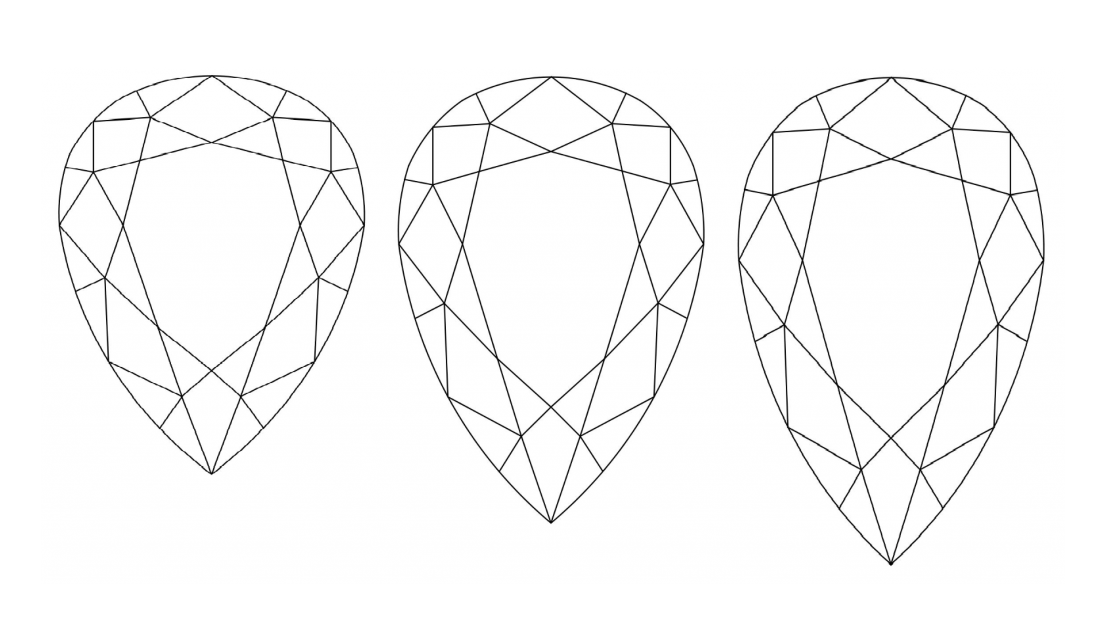
The following cut, color, and clarity guides should be taken into consideration when choosing a Pear shaped diamond:
The cut attributes of a diamond contribute to its sparkle, brilliance, and bling. Most knowledgeable buyers would choose attributes from the Excellent – Very Good columns.
| Excellent | Very Good | Good | Fair | Poor | |
| Table % | 53 – 62.9 | 52 – 52.9 or 63 – 65.9 | 51 – 51.9 or 66 – 68.9 | 50 – 50.9 or 69 – 70.9 | <49.9 or >71 |
| Depth % | 58 – 62.9 | 56 – 57.9 or 63 – 65.9 | 53 – 55.9 or 66 – 70.9 | 50 – 52.9 or 71 – 74.9 | <49.9 or >75 |
| Girdle | Very Thin to Slightly Thick | Very Thin or Thick | Very Thin or Very Thick | Extremely Thin or Extremely Thick | |
| Culet | None | Very Small | Small | Medium | > Medium |
Length-to-Width Ratio
A classic Pear Shaped diamond has a length-to-width ratio between 1.55 – 1.62.
| Excellent | Very Good | Good | Fair | Poor | |
| Square | 1.55 – 1.62 | 1.50 – 1.59 or 1.63 – 1.67 | 1.45 – 1.49 or 1.68 – .175 | 1.40 – 1.44 or 1.76 – 2.00 | >1.39 or >2.00 |
Pear Shaped Diamond Polish, Cut and Fluorescence
Our experience suggests that Cut, Symmetry, Polish, and Fluorescence contributes to a diamond’s brilliance so that most buyers will choose Excellent – Very Good and Fluorescence None – Faint.
| Excellent | Very Good | Good | Fair | Poor | |
| Cut | Excellent | Very Good | Good | Fair – Poor | |
| Polish | Excellent | Very Good | Good | Fair – Poor | |
| Symmetry | Excellent | Very Good | Good | Fair – Poor | |
| Fluorescence | None | Faint | Medium | Strong – Very Strong |
Pear Shaped Diamonds: Pros and Cons
There are advantages and disadvantages to every cut, including the Pear Shaped diamond.
Pros
An advantage of the Pear is that it makes your finger look thinner and longer, due to its length. Another advantage is the choice of how to wear it. Brides can choose to wear it tip up or tip down, depending on personal preference.
It’s also a great choice if you like the Marquise diamond cut, but don’t want to sacrifice sparkle at both ends of the diamond. This way, you can get the best of both worlds and take advantage of the high brilliance of the curved end, and the bold, dramatic point of the diamond’s tip.
Disadvantages
A disadvantage of the Pear is its bow-tie effect. Because of its narrow shape, the Pear shape can produce an area of reduced color in the center of the gem, resembling a bow tie or ribbon. This can really interrupt the beauty of the stone, so make sure you’re on the lookout during your consultation. Keep reading to find out more about the bow tie effect in Pear diamonds.
Another disadvantage is the fact that the Pear, unlike some other diamond shapes, tends to come in and out of fashion every few years – but, the important thing to remember is that it always comes back. What’s more, what’s ‘in fashion’ is irrelevant once you find the ring.
Choosing a Pear Cut Diamond: Key Factors to Consider
Avoiding the Bow Tie Effect in Pear Cut Diamonds
Some of the more elongated shapes, like the Pear and Marquise, are vulnerable to a pretty significant dark spot that runs through the center of the diamond, in a shape that is often likened to a black bow tie.
In many diamonds, this effect is subtle enough to go unnoticed most of the time, but it is important to understand what causes this effect – and how to avoid it – if you’re shopping for a Pear.
A bow tie is caused when light is unable to refract properly through the center of the stone, creating some pretty major ‘dark spots’ within the stone.
It is a result of the fact that creating a cut that is beautiful (and free from dark spots) from all angles is an incredibly complex process, and one that doesn’t always work out.
Finding out whether or not the diamond you are looking at features a bow tie is simply a matter of looking at it, but it can be tricky through a screen. That’s why an entire step in our diamond QA process is focused on bow ties, and preventing any diamonds with significant bow ties from being made available to our customers.
At WillYou, we don’t want our customers to purchase any diamond we wouldn’t be happy with. Bow ties are always at the forefront of our minds when it comes to quality checking Pear diamonds.
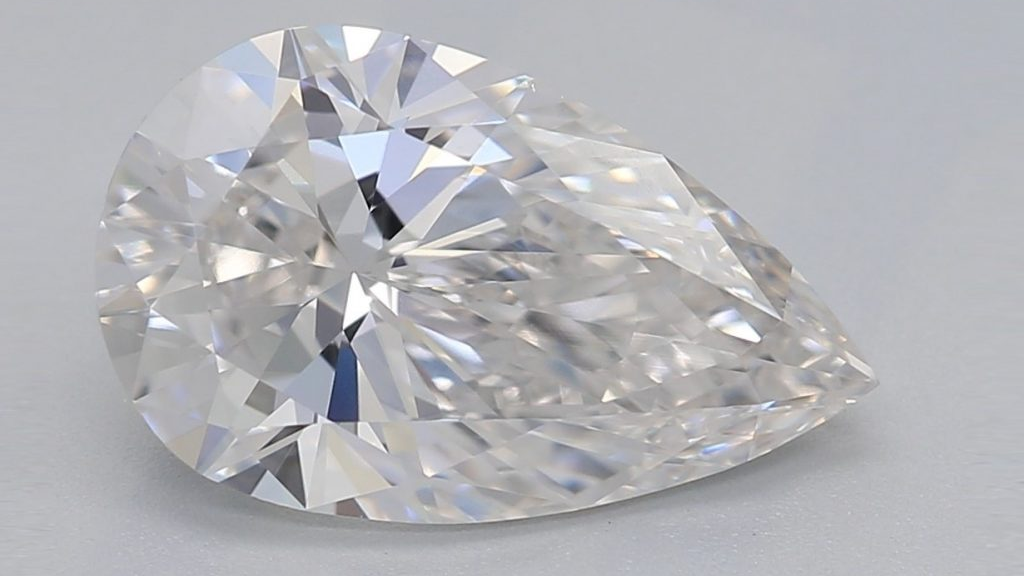
Pear Shaped Diamond Color Guide
Most buyers prefer size over color hue and will buy a diamond of G color.
| Excellent | Very Good | Good | Fair | Poor | |
| < 0.5 ct. | D – G | H – I | J – K | L – M | > N |
| 0.51 – 1.00 ct. | D – F | G – H | I – J | K | > J |
| 1.00 – 2.00 ct. | D – F | G – H | I – J | K | > J |
| > 2.00 ct. | D – F | G – H | I – J | K | > J |
Pear Shaped Diamond Clarity Guide
Most buyers prefer size over clarity and will buy a diamond of SI1 Clarity.
| Excellent | Very Good | Good | Fair | Poor | |
| < 0.5 ct. | FL -VS2 | SI1 – SI2 | I1 – I2 | > I2 | |
| 0.51 – 1.00 ct. | FL -VS1 | VS2 – SI1 | SI2 | I1 – I2 | > I2 |
| 1.00 – 2.00 ct. | FL -VS1 | VS2 – SI1 | SI2 | I1 | > I1 |
| > 2.00 ct. | FL -VS1 | VS2 – SI1 | SI2 | I1 | >I1 |
Pear Diamond Snagging
Pears may snag on clothing from time to time. The Pear’s sharp point can prove a little more unwieldy than some of the more ‘aerodynamic’ shapes, like the Round, oval and Cushion, but most wearers will get used to wearing it very quickly.
An additional prong at the Pear’s tip, as in this Pear Shaped Solitaire Engagement Ring, can offer a little extra protection to the diamond, if you’re worried about durability.
Pear Diamond Cost Considerations
Whatever your price point, it always comes right back around to price in the end. It can be confusing for newcomers to realize that predicting diamond prices means accounting for a wide range of factors – including shape – but, once you get your head around it, the going will get much easier.
Compared with the Round Brilliant, the Pear costs around 30% to 35% less, making it much easier for you to pick out a larger diamond, or one with a higher clarity, at your price point.
Nevertheless, quality should never be sacrificed for the sake of price. With some knowledge and savvy by your side, however, it’s totally possible for you to get an incredibly good price on a Pear cut.
Why Pear Diamonds are Cheaper Than Other shapes
Popularity has driven up the prices of some of the more popular cuts, meaning that the Pear – which isn’t consistently popular among couples – represents one of the more affordable cuts.
Also, unlike the Round, it’s possible for diamond cutters to preserve a lot of the original rough stone when making this shape, and this significantly influences the overall cost of one of these diamonds.
Diamond cutters are always looking to get the biggest diamonds possible out of their rough stones, and the Pear requires much less of a sacrifice than some of the more complex shapes.
Average Price Range for Pear Diamonds
For a good quality diamond, you can expect to pay around $3,000+, with factors like clarity, color and cut bringing the price as high as $10,000 – or, in rare cases, even higher.
Remember that carat is only one of the forces driving a diamond’s value higher, but that you don’t need to go to the very top grade in the rest of the Four Cs to find a beautiful and eye clean diamond.
We will go into more detail below about the ideal grades across Color, Cut, Clarity – and other factors like fluorescence – but, for now, it’s useful to know that it’s possible to find a knock-out 1 carat Pear between $3,000 and $6,000.
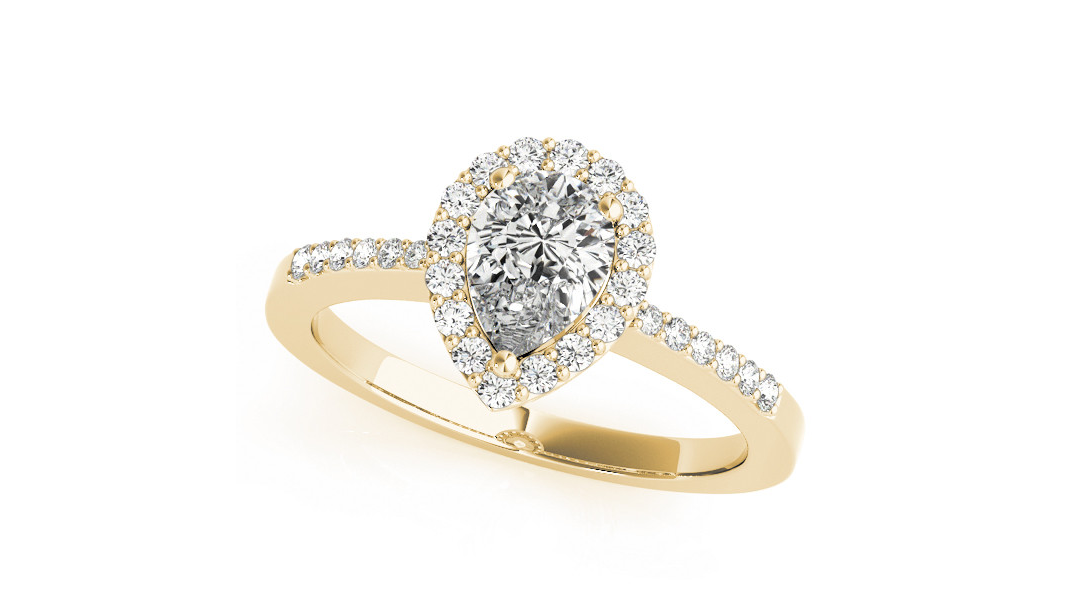
Pear Diamond Engagement Rings
While the diamond is beautiful enough on its own, it’s impossible to know whether or not it makes the perfect engagement ring before you find out more about this unique cut.
Positioning the Pear on the Finger
There is no ‘right’ or ‘wrong’ way, but the most common way to wear a Pear is with the tapered end pointed away from the wearer, and toward the fingertip.
While this is considered the ‘norm’, a Pear can be worn so that the tapered end points toward the knuckles – or, much more rarely, in an East-West configuration. This creates a highly asymmetrical ring with a bold, contemporary charm.
And, while it is most commonly used as a center stone in engagement rings, it also offers a beautiful choice as a side or accent stone, too – particularly when placed in that East-West configuration.
In truth, there are no rules concerning the Pear’s arrangement – or how it’s worn – only personal preference.
The Pear Diamond Trend Cycle
Unlike some of the more traditional diamond shapes like the Round and Emerald, the Pear’s popularity among couples tends to ebb and flow.
Then again, what’s more important is the fact that the Pear shaped diamond will always be a beautiful and arresting center stone for any ring. Yes, there will be times when it finds more favor among public figures and celebrities – and, of course, times when it is no longer sitting front-and-center in every jewelry store window – but, no matter what, it will look stunning.
An engagement ring’s significance – and, indeed, what you and your bride to be think of the ring – goes far beyond a trend or fashion, so it’s important that you don’t get too hung up on this side of things as you make your choice.
This sleek and elegant Pear Cathedral Engagement Ring will continue to look graceful throughout the decades, while the absolutely incredible level of sparkle offered by this Pear Pavé Engagement Ring design checks all the boxes for brilliance, beauty and grandeur.
Our Expert Take
The Pear is beautiful, but it’s not for everyone. This is a bold cut, featuring a rare asymmetry, a dramatic point, and a unique combination of shapes. It’s going to be a perfect shape for some, and a controversial choice for others.
Then again, it’s got plenty going in its favor – particularly if you have a sneaking suspicion that your partner is as drawn-in by this fascinating shape as you are. For one thing, it looks bigger than many of the other shapes; for another, you get to enjoy the best of both worlds by combining the curve of the Oval with the length and precise point of the Marquise.
The Pear cut creates beautiful engagement rings, whether it’s featured at the very center of the ring, or as an accent on the side. Provided you think carefully about this diamond – both in terms of your bride-to-be’s style and the potential for a bow tie or poor shape – it could easily turn out to be the perfect choice.
10 FAQs
- Q: What is a Pear Shaped Diamond?
- A: A pear-shaped diamond combines the features of a round and a marquise cut, resembling a teardrop. It’s rounded at one end and tapers to a point at the other.
- Q: Why Choose a Pear Shaped Diamond?
- A: Pear-shaped diamonds are unique and versatile, often appearing larger than their actual size due to their elongated shape. They’re ideal for someone seeking a distinctive and elegant diamond.
- Q: How Should a Pear Shaped Diamond be Worn?
- A: Typically, pear-shaped diamonds are worn with the pointed end facing towards the fingernail. This orientation accentuates the finger’s length and the diamond’s shape.
- Q: What to Look for in a Pear Shaped Diamond?
- A: Focus on the length-to-width ratio for the desired shape, symmetry for balance, a minimal bow-tie effect, appropriate color and clarity grades, and a setting that protects the pointed end.
- Q: Are Pear Shaped Diamonds More Expensive?
- A: Pear-shaped diamonds are generally less expensive than round diamonds. Their unique cut and lesser demand compared to round diamonds often result in more affordable prices.
- Q: How to Protect the Point of a Pear Shaped Diamond in a Ring?
- A: Choose a setting with a V-shaped prong at the tip of the diamond. This design helps protect the pointed end from chipping or snagging.
- Q: Do Pear Shaped Diamonds Have a Bow-Tie Effect?
- A: Yes, most pear-shaped diamonds have a bow-tie effect, which is a dark area across the middle resembling a bow tie. The visibility of this effect varies and should be minimal for a well-cut diamond.
- Q: What Settings are Best for Pear Shaped Diamonds?
- A: Popular settings include the solitaire, halo, and prong settings. Choose a design that enhances the diamond’s shape and offers protection for the pointed end.
- Q: Can Pear Shaped Diamonds Chip Easily?
- A: The pointed end of a pear-shaped diamond can be prone to chipping if not properly protected. A well-designed setting is essential to safeguard the stone.
- Q: What is the Ideal Length-to-Width Ratio for a Pear Shaped Diamond?
- A: The ideal ratio typically ranges from 1.55 to 1.75. This range ensures a balanced appearance between elongation and roundness.
Discover your perfect pear shaped diamond with Jeweler AI, where elegance meets precision.
FOLLOW-UP GUIDE SERIES

